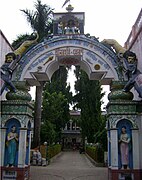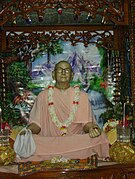Sri Devananda Gaudiya Math
| Sri Devananda Gaudiya Math | |
|---|---|
श्री देवानंद गौडीय मठ, শ্রী দেবানন্দ গৌড়ীয় মঠ | |
 The Spire of Sri Devananda Gaudiya Math, Nabadwip, West Bengal | |
| Religion | |
| Affiliation | Hinduism |
| District | Nadia |
| Deity | Sri Gauranga, Radha Vinod Bihari Jiu, Lakshmi Varahadev, Jagannath Dev, Bhakti Siddhanta Saraswati Prabhupad, Bhakti Prajnana Keshav Goswami Thakur, Bhakti Vedanta Baman Goswami Maharaj |
| Festivals | Dolyatra, Ratha Yatra, Jhulan-Janmashtami, Bhakti Prajnan Keshav Goswami Maharaj and Bhakti Vedanta Vaman Goswami Maharaj's Vyas Puja & Tirobhav Mahotsav |
| Location | |
| Location | Teghori Pada |
| State | West Bengal |
| Country | India |
| Geographic coordinates | 23°23′52″N 88°21′47″E / 23.3976678°N 88.3629921°E |
| Architecture | |
| Type | Hindu temple architecture |
| Creator | Srila Bhakti Prajnana Kesava Gosvami Maharaja |
| Completed | 1940 |
| Website | |
| www | |
Sri Devananda Gaudiya Math (also Matha, or Mutt) is situated at Teghori Pada in Nabadwip dham of district Nadia in the West Bengal state of India, and is a matha and prominent holy place of the Gaudiya Vaishnavas, as well the headquarters of the Sri Gaudiya Vedanta Samiti. It is located in the middle of the place earlier known as Koladvipa. Math has been continuing as a famous religious spot thronged by thousands of devotees every year.[1]
Gaudiya Vedanta Samiti
[edit]The Sri Gaudiya Vedanta Samiti or Gaudiya Vedanta Samiti (GVS) is the one of oldest Gaudiya Vaishnava missionary and monastic organisations, established in 1940 in British India. Its founder-president-acharya became Srila Bhakti Prajnana Kesava Gosvami Maharaja.[2][3]
In April 1940, after the prominent guru-reformer Srila Bhaktisiddhanta Sarasvati Thakura Prabhupada entered aprakata-lila (departure), Srila Bhakti Prajnana Kesava Gosvami Maharaja as one of his disciples and former member of the defunct Gaudiya Math, established the Gaudiya Vedanta Samiti (lit. "Gaudiya Vedanta Society") in a rented building in Calcutta. He later purchased an extensive piece of land at Nabadwip on which he established Sri Devananda Gaudiya Math with a beautiful temple. The Math became the headquarters of a new mission with branches across India, predominantly in West Bengal, Assam and Odisha.
The monks, whose sannyasa guru was Srila Bhakti Prajnana Kesava Gosvami Maharaja, received the name Bhakti Vedanta, one of them, A.C. Bhaktivedanta Swami Prabhupada, the founder of the ISKCON.[3][4]
According to official website of the organisation, its present president-acharya is Bhakti Vedanta Budhayan Goswami since 2020.
Inside the Temple
[edit]The following deities preside in the five chambers of the temple and samadhi mandir respectively:
Temple
- Srila Bhaktisiddhanta Sarasvati Thakura Prabhupada,
- Sri Gauranga and Sri Radha-Vinoda-bihari, and
- Sri Koladeva, or Varahadeva, the presiding deity of Sri Koladvipa.
Samadhi
- Srila Bhakti Prajnana Kesava Gosvami Maharaja
- Srila Bhaktivedanta Vamana Gosvami Maharaja
Nava-vidha Bhakti
[edit]
The temple's nine towers each represent one limb of nava-vidha-bhakti, the nine types of devotional service.
- Hearing,
- Chanting,
- Remembering,
- Serving the Lord's lotus feet,
- Worshipping,
- Offering prayers,
- Engaging as a servant,
- Serving as a friend, and
- Completely surrendering oneself.
Nava-vidha Khandas
[edit]
The matha is divided into the following nine parts (khandas):
- Paramartha-khanda – the printing press where devotional literature and magazines are produced.
- Kirtana-khanda – the place where sankirtana, lectures on Bhagavatam and other scriptures take place.
- Upasya-khanda – the temple where the deities of Srila Sarasvati Thakura Prabhupada, Sri Gauranga, Sri Radha-Vinona-bihari and Sri Koladeva are worshipped.
- Sevaka-khanda – the place where the residents of the matha live.
- Bhoga-khanda – the storehouse and kitchen.
- Govardhana-khanda – the cow shed.
- Vaisnnava-granthagara-khanda – the library.
- Udayana-Khanda – the garden.
- Jnana-khanda – the bathrooms and latrines.
These sections are divided on the basis of activities favourable to bhakti, which are to be accepted and those unfavourable which are to be avoided. Jnana and karma which are devoid of bhakti are always to be rejected just as one rejects stools. For this reason the bathrooms and latrines of the matha are called Jnana-khanda.
It was Srila Bhaktisiddhanta Sarasvati Gosvami's long-held desire that a deity of Sri Koladeva be established on the Ganga's western bank in the old Kuliya-nagara. To fulfill this desire, Srila Bhakti Prajnana kesava Gosvami Maharaja has manifested the service of Sri Koladeva at the place.
The Past and the Present
[edit]- Srila Bhakti Prajnana Kesava Gosvami Maharaja – Founder Acharya.
(Pre-ISKCON and sannyasa guru of A.C. Bhaktivedanta Swami Prabhupada.[3][4]
- Srila Bhakti Vedanta Bamana Goswami Maharaja – next Acharya.
- Srila Bhakti Vedanta Paryataka Maharaja – present Acharya.
- Srila Bhakti Vedanta Acharya Maharaja – present Secretary.
Gallery
[edit]-
The dome of Sri Devananda Gaudiya Math.
-
The entrance (torana) of Sri Devananda Gaudiya Math.
-
Samadhi Mandir of Srila Bhakti Prajnana Kesava Gosvami Maharaja and Srila Bhakti Vedanta Bamana Goswami Maharaja.
-
Samadhi of Srila Bhakti Vedanta Bamana Goswami Maharaja.
-
Sri Koladeva, or Varahadeva, the presiding deity of Sri Koladvipa.
See also
[edit]References
[edit]Footnotes
[edit]- ^ Maharaja 2005, pp. 143–145.
- ^ Brzezinski 2004, p. 89.
- ^ a b c Sherbow 2004, p. 131.
- ^ a b Broo 2003.
Bibliography
[edit]- Secondary sources
- Broo, Måns (2003). As good as God: the guru in Gauḍīya Vaiṣṇavism (PDF). Åbo: Åbo Akademi University Press. ISBN 951-765-132-5. Archived from the original (PDF) on 2016-03-06.
- Brzezinski, Jan (2004). "Charismatic Renewal and Institutionalization in the History of Gaudiya Vashnavism and the Gaudiya Math". In Bryant, Edwin F.; Ekstrand, Maria L. (eds.). The Hare Krishna Movement: The Postcharismatic Fate of a Religious Transplant. New York: Columbia University Press. pp. 73–96. ISBN 0-231-12256-X.
- Rosen, Steven J. (1994). Vaishnavism: Contemporary Scholars Discuss the Gaudiya Tradition. Motilal Banarsidass. ISBN 81-208-1235-2.
- Sherbow, Paul H. (2004). "A.C. Bhaktivedanta Swami's Preaching in the Context of Gaudiya Vashnavism". In Bryant, Edwin F.; Ekstrand, Maria L. (eds.). The Hare Krishna Movement: The Postcharismatic Fate of a Religious Transplant. New York: Columbia University Press. pp. 129–46. ISBN 0-231-12256-X.
- Primary sources
- Maharaja, Swami Bhaktivedanta Narayan (2008). Sri Navadvipa-dhama – page 171. Sri Gaudiya Vedanta Samiti (GVS). ISBN 978-8186737569.
- Maharaja, Swami Bhaktivedanta Narayan (1999). Acarya Kesari Sri Srimad Bhakti Prajnana Kesava Gosvami – His Life and Teachings (1st ed.). GVP. pp. 571 pages. ISBN 81-86737-14-6.
- Maharaja, Sri Srimad Bhaktivedanta Narayana (2005). Sri Navadvipa-dhama and Prominent Holy Places of the Gaudiya Vaisnavas in Sri Gauda-mandala. Gaudiya Vedanta Publications. ISBN 81-86737-56-1.
- Dasa Goswami, Satsvarupa (2002). Srila Prabhupada Lilamrta. Vol. 2 (2nd ed.). p. 1191. ISBN 0-89213-357-0.
External links
[edit]- Sri Gaudiya Vedanta Samiti official website
- The Brahma-Madhva-Gaudiya Disciplic Succession and Its Unique Characteristics of Which We are a Part
- Navadvipa Parikrama 2010 - Sripad Madhava Maharaja translated into English Srila Gurudeva’s short Bengali discourse.
- Sri Srimad Bhakti Prajnana Kesava Goswami - The founder of Sri Devananda Gaudiya Matha.[usurped]







